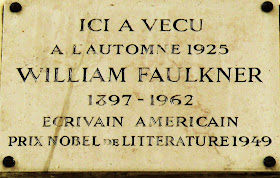26 rue Servandoni, near the Jardin du Luxembourg, is where Southern writer William Faulkner lived in the autumn of 1925.
'ICI A VÉCU
À L'AUTOMNE 1925
WILLIAM FAULKNER
1897 — 1962
ÉCRIVAIN AMÉRICAIN
PRIX NOBEL DE LITTÉRATURE 1949'
Gabriel Marcel lived at 21 rue de Tournon for forty years, from 1933 until his death in 1973.
'GABRIEL MARCEL
PHILOSOPHE ET DRAMATURGE
1889 - 1973
A VÉCU DANS CETTE MAISON
DE 1933 JUSQU'À LA FIN
DE SA VIE'
Almost opposite this, 18 rue de Tournon is where the Austrian writer Joseph Roth lived from 1937 to 1939.
'ICI A RÉSIDÉ DE 1937 À 1939
LE CÉLÈBRE ÉCRIVAIN AUTRICHIEN
JOSEPH ROTH
HOMMAGE DE SES AMIS AUTRICHIENS'
Hôtel Fontaines du Luxembourg, 4 rue de Vaugirard, where Paul Verlaine stayed from March 1889 to December 1894.
'De mars 1889 à décembre 1894 le poète Paul Verlaine a fréquenté cet hôtel.'
Verlaine later moved to what is now called La Maison de Verlaine at 39 rue Descartes, where he died in 1896, and where his friends erected a plaque:
'Dans cette maison est mort
le 8 janvier 1896 le poète
Paul VERLAINE
né à Metz le 30 mars 1844
Hommage des amis de VERLAINE
29 juin 1919'
Next to La Maison Verlaine, at 37 rue Descartes, is where the Japanese writer Kunio Tsuji lived from 1980 to 1999.
'L'écrivain japonais
Kunio Tsuji
a séjourné
dans cet immeuble
de 1980 à 1999'
The area around the Sorbonne is steeped in literature, as in this poem by Yves Bonnefoy on a wall in rue Descartes, illustrated by the drawing of the tree by Pierre Alechinsky. I'm not in the business of translating literature as translation so often reduces, truncates, distorts, even misses the point completely. At best, perhaps, trying to convey the spirit of a work, it gives a reasonable idea of what the author is saying.
Here, Bonnefoy represents the tree as a symbol, a force of light against darkness, the natural world, something soaring, something much bigger than itself, something beyond the dirt of the street: all this he addresses, literally, to the man in the street in two verses. The third verse he addresses to the philospher, telling him or her of the power of freedom that the tree possesses, an ability to render his or her thoughts more positive.
'Passant,
regarde ce grand arbre
et à travers lui
il peut suffire.
Car même déchiré, souillé
l'arbre des rues,
c'est toute la nature,
tout le ciel,
l'oiseau s'y pose,
s'y bouge, le soleil
y dit le même espoir malgré
la mort.
Philosophe,
as-tu chance d'avoir l'arbre
dans la rue,
tes pensées seront moins ardues,
tes yeux plus libres,
tes mains plus désireuses
de moins de nuit.'
France loves its philosophers, and here's Le Descartes, a brasserie/café bar with students sitting outside, on the corner of rue du Cardinal Lemoine and rue Thouin.
At 74 rue Cardinal Lemoine is a shop called 'Under Hemingway's'. The plaque states that Ernest Hemingway lived on the third floor of the building with his wife Hadley from January 1922 until August 1923. It goes on to say that he especially loved this area, where his pared-down style of writing was born. He was on good terms with his neighbors, particularly the patron of the bal-musette. The plaque concludes with a quotation from Hemingway's love story to Paris, A Moveable Feast, where he writes that his youth there was poor but happy.
'De janvier 1922 à août 1923 a vécu, au troisième étage de cet immeuble, avec Hadley, son épouse, l'écrivain américain
Ernest HEMINGWAY
1899 — 1961
Le quartier, qu'il aimait par-dessus tout, fut le véritable lieu de naissance de son oeuvre et de son style dépouillé qui le caractérise. Cet Américain à Paris entretenait des relations familières avec ses voisins, notamment le patron du bal-musette attenant.
"Tel était le Paris de notre jeunesse, au temps au où nous étions très pauvres et très heureux."
Ernest Hemingway (Paris est une fête)
Valery Larbaud lived for almost twenty years at 71 rue Cardinal Lemoine , and welcomed James Joyce, who finished Ulysses here.
'Valery LARBAUD
(1881 - 1957)
Poète, romancier,
essayiste, traducteur
vécut ici de 1919 à 1937'
'James JOYCE
(1882 — 1941)
écrivain brittanique
d'origine irlandaise
accueilli par Valery Larbaud,
a achevé ici son roman "Ulysses",
ouvrage majeur de la littérature
du vingtième siècle.'
At the north side of the Panthéon (blog post to come later) is a statue of playwright Pierre Corneille (1606—84).
And at the south side, a statue of Jean-Jacques Rousseau (1712—78).
Off the boulevard St-Michel, a hundred meters or so from the Sorbonne, is a statue of Auguste Comte.
Hôtel des 3 Colleges has an impressive way of boasting about its visitors.
This elaborate plaque, including a representation of Gabriel García Marquéz's head, annouces that the Columbian Nobel prize winner wrote the novel No Letter for the Colonel here in 1959.
And this plaque, that the Hungarian poet Miklós Radnóti lived there in 1939.
"...des poètes entiers, la liberté te clament. Ainsi dans Paris, ses chants d'aujourd'hui'.






























No comments:
Post a Comment